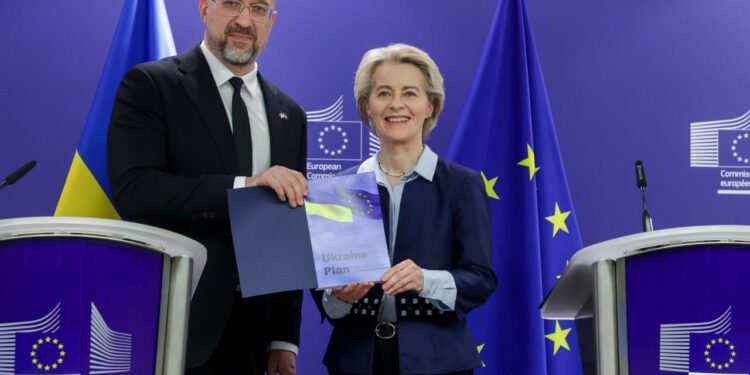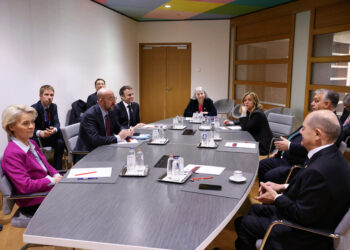Brussels – The Ukraine Facility officially goes live with the first payment from Brussels to Kyiv, just over a month after EU institutions agreed to give stable and predictable macro-financial support until 2027. “We have just paid Ukraine the first tranche of 4.5 billion euros in the form of bridge financing. It is crucial to help you maintain the functioning of the state in this very difficult moment,” European Commission President, Ursula von der Leyen announced in a press point in Brussels today (March 20) alongside Ukrainian Prime Minister, Denys Shmyhal. 
The disbursement of the first tranche of funding from the Ukraine Facility – which will mobilize 50 billion euros over four years to support public wages, pensions, and basic public services in the war-torn country – is part of the unveiling of the Plan for Ukraine, one of the three pillars of the Union’s new financial instrument. “Your (the Ukrainian government’s) success in delivering the Plan today is all the more impressive, since it is only 19 days ago that the Ukraine Facility entered into force,” President von der Leyen said, speaking of the program that “maps out how Ukraine can get back to rapid growth and start to recover the losses that the war has caused.” The Commission, for now, has provided exceptional support – bridge funding – until the Ukraine Plan receives the green light, subject to the fulfillment of political conditions and reporting requirements. “In April, once Ukraine fulfills the conditions we agreed upon, we will make a second disbursement of the bridge financing of 1.5 billion euros,” von der Leyen added.
In the meantime, the Commission will begin to “carefully” evaluate the Plan that will ensure the smooth flow of funding until 2027. It should be a program that presents “the same approach developed in the EU” and “combines reforms and investments. This will boost growth and at the same time help Ukraine move closer to our Union,” von der Leyen said. The EU executive will also have to assess whether Ukraine’s proposed measures can ensure “an adequate level” of protection of the Union’s financial interests, after which a recommendation will come to the Council to implement the Plan (within a month), with indicators of the reforms and investments necessary for the disbursement of financial support. At the conclusion of this process, Kyiv will immediately benefit from a €1.9 billion pre-financing, followed by regular quarterly payments. “This is by far the largest support program for Ukraine. It is three times bigger than the IMF program… and will form a key reference point for other donors,” von der Leyen stressed.
Premier Shmyhal detailed Kyiv’s action under the Plan presented today at the Commission: “The Plan envisages almost 70 reform areas including structural reforms in the public sector, a number of economic reforms aimed at developing the business climate“ in energy, logistics, agriculture, critical raw materials, and information technology.” In addition, of the over 50 billion provided by the Ukraine Facility, the Ukrainian government plans to allocate “38.8 million as budget support, 7 billion to stimulate investment for the economy and attract investment, and 4.7 billion to implement reforms and capacities of public authorities,” Prime Minister Shmyhal explained.
How the Ukraine Tool works
The 17 billion euros in grants that Brussels plans to allocate will be mobilized through the Ukraine instrument agreed by 27 EU leaders under the revised Multiannual Financial Framework, while 33 billion in loans will be secured from the own resources reserve, just as in the financing under the Macro-Financial Assistance Plus (MFA+) which mobilized 18 billion throughout 2023. Under the Plan for Ukraine, Kyiv can apply for up to 7 percent in pre-financing, with “a significant share” of the first two pillars earmarked for green investments and another part of the Investment Framework reserved for small and medium-sized enterprises.

Considering the country is still at war, the plan will allow some flexibility in budget management. However, the prerequisite for support under the new financial instrument is the respect of democratic mechanisms: multi-party parliamentary system, rule of law, and human and minority rights. The Regulation establishing the Ukraine Facility ensures that the Verchovna Rada (the Ukrainian Parliament) and civil society organizations are “duly informed and consulted” on the design and implementation of the first pillar on recovery and reform intentions for EU accession. On the EU side, the Council will hold an annual debate based on the Commission’s special reports on the instrument’s implementation. The European Parliament can invite the EU executive to discuss it at least every four months. In this regard, the Regulation includes a scoreboard to make it easier to monitor the progress of the various phases, including an overview of the social, economic, and environmental elements of the Ukraine Plan.
English version by the Translation Service of Withub






